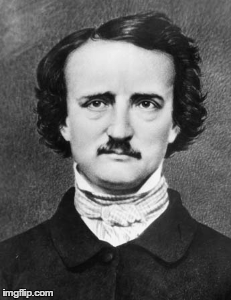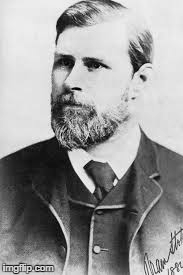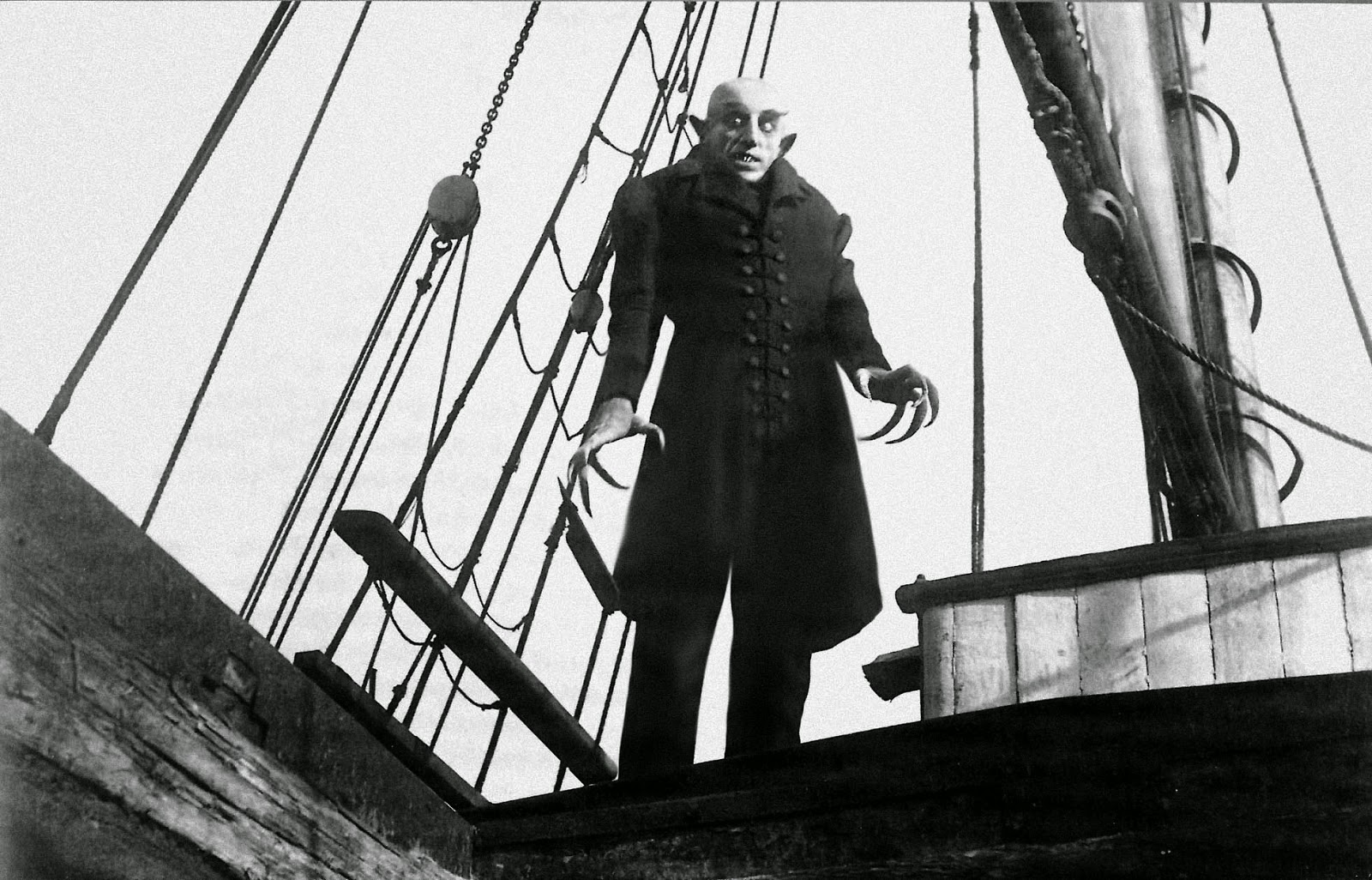 |
| Adaption of Edgar Allen Poe's The Fall of the House of Usher |
 |
| Bram Stoker's famous Gothic novel, Dracula |
 |
| Mary Shelley's Frankenstein |
The horror genre is inspired by speculative fiction, specifically Gothic horror. This genre was made popular in the late 18th century, through novels such as Mary Shelley's Frankenstein (1818), Robert Louis Stevenson's Strange Case of Doctor Jekyll and Mr Hyde (1886), Bram Stoker's Dracula (1897) and the works of Edgar Allen Poe (early 19th Century). The term Gothic refers to the medieval style of
buildings the stories were set in, for example Dracula's castle. Gothic horror was popular in literature and theatre so naturally early filmmakers took inspiration from these.
'Le Manoir du Diable' or Manor of the Devil (1896) by the French early filmmaker Georges Méliès is considered the first horror
film ever made. It shows two cavaliers who kill a reincarnation of the devil.
Frankenstein (1910), Dr. Jekyll and Mr. Hyde (1913), The Avenging Conscience (1914), The Crimson Stain Mystery (1916) and The Golem Trilogy are examples of silent films from the 1910s that began to establish the conventions of the horror genre, shocking the audience. The films of this era all draw from the supernatural elements touched upon by Gothic horror literature such as monsters in Frankenstein and The Crimson Stain Mystery and ghosts and spirits in The Avenging Conscience.
The German expressionism movement during the post war years affected cinema and produced many famous early horror films. Favouring expressionism over a realistic view of
the world was effective in films such as Nosferatu (1922) and the Cabinet of Doctor Caligari (1920). Electricity quotas in the Weimar Republic meant filmmakers painted
shadows onto the set instead of wasting electricity on necessary lighting. This became characteristic of the expressionist films. German filmmakers moved to Hollywood during the rise of the Nazis, where their cinematography influenced the horror and film noir genres.
The Jazz Singer, released in October 1927, was the first feature film to use synchronized sound, marking the decline of silent cinema and the beginning of "talkies". This meant that horror films could now feature the sound effects and music that would made them even more sinister. The first "talking" horror film was The Terror (1928).
In the 1930's, Gothic horror was still popular. The stories of Frankenstein Dr. Jekyll and Mr. Hyde and Dracula were retold in sound in 1931 and are iconic performances even today. They were so popular they produced numerous spin offs throughout the decade, such as Bride of Frankenstein (1934), Dracula's Daughter (1936) and Son of Frankenstein (1939). In the early 1940's there were even crossovers such as House of Frankenstein (1944) and House of Dracula (1945). Other notable horror films from the 1930's include Werewolf of London (1935), The Invisible Man (1933) and The Black Cat (1934). Many horror films from this era were produced by Universal Studios, and are consequently called Universal Monsters.
Universal continued this cycle of films into the 1940's with films like The Wolf Man (1940). By the middle of the decade audiences were bored with seeing the same Gothic horror figures, however a new sub-genre had emerged; thrillers. The outbreak of the Second World War led to a decline in the film industry, and with less money available thrillers proved easier to produce for less without the extravagant costumes and special effects of the Universal Monsters. Some examples of psychological thrillers are early Hitchcock films like Rebecca (1940) and Shadow of a Doubt (1943). Cat People (1942) is a famous supernatural thriller of the period.
In the 1930's, Gothic horror was still popular. The stories of Frankenstein Dr. Jekyll and Mr. Hyde and Dracula were retold in sound in 1931 and are iconic performances even today. They were so popular they produced numerous spin offs throughout the decade, such as Bride of Frankenstein (1934), Dracula's Daughter (1936) and Son of Frankenstein (1939). In the early 1940's there were even crossovers such as House of Frankenstein (1944) and House of Dracula (1945). Other notable horror films from the 1930's include Werewolf of London (1935), The Invisible Man (1933) and The Black Cat (1934). Many horror films from this era were produced by Universal Studios, and are consequently called Universal Monsters.
 |
| Boris Karloff, Lon Chaney and Bela Lugosi, three of the most famous Universal Monsters Actors  |
Universal continued this cycle of films into the 1940's with films like The Wolf Man (1940). By the middle of the decade audiences were bored with seeing the same Gothic horror figures, however a new sub-genre had emerged; thrillers. The outbreak of the Second World War led to a decline in the film industry, and with less money available thrillers proved easier to produce for less without the extravagant costumes and special effects of the Universal Monsters. Some examples of psychological thrillers are early Hitchcock films like Rebecca (1940) and Shadow of a Doubt (1943). Cat People (1942) is a famous supernatural thriller of the period.
Horror films of the 1950's influenced by fear of communism and the ongoing Cold War. Films such as Godzilla (1954), Invasion of the Body Snatchers (1956) and Attack of the Giant Leeches (1959) used the contemporary audience's fear of invasion and, occasionally, nuclear weaponry to frighten them. The genre also became increasingly popular among teenagers during this time, who wanted a thrill despite the plot line. One of the most famous horror films from the 1950's is the monster film Creature from the Black Lagoon (1954).
Hitchcock's Psycho (1960), arguably one of the most iconic horror films, was produced in the 1960's. It did not feature or a supernatural element but realistic characters, which was frightening for the audience because it made them feel more vulnerable. Many films throughout the era would copy this idea.
The late 1960's notably saw the end of the Production Code, which had restrictions regarding sex, violence, death and costume. This meant horror films could now show more frightening scenes (in terms of how graphic they were).
In 1968, Rosemary's Baby was released. It was highly controversial at the scene, with satanist themes and the protagonist being raped by the devil. It did inspire a series of occult horror films over the next decade. Famous satanic films include The Exorcist (1973), The Devil's Rain (1975) and The Omen (1976). Even presently satanic films prove popular- for example Constantine (2005) and The Exorcism of Emily Rose (2005).

During the 1970's, lots of iconic horror films were produced, which some critics suggest reflected the mood of the time. There were also many new sub-genres that became popular, instead of the set cycles found in the early 20th century. Carrie (1976), a teen horror film, was a massive commercial success. The slasher genre was considered to be at its peak from the mid 1970's-1980's due to the reception of films such as Texas Chainsaw Massacre (1974), Halloween (1978) and Nightmare on Elm Street (1984). Another creditable horror film from this time is Stanley Kubrick's psychological thriller The Shining (1980).
Hitchcock's Psycho (1960), arguably one of the most iconic horror films, was produced in the 1960's. It did not feature or a supernatural element but realistic characters, which was frightening for the audience because it made them feel more vulnerable. Many films throughout the era would copy this idea.
The late 1960's notably saw the end of the Production Code, which had restrictions regarding sex, violence, death and costume. This meant horror films could now show more frightening scenes (in terms of how graphic they were).
In 1968, Rosemary's Baby was released. It was highly controversial at the scene, with satanist themes and the protagonist being raped by the devil. It did inspire a series of occult horror films over the next decade. Famous satanic films include The Exorcist (1973), The Devil's Rain (1975) and The Omen (1976). Even presently satanic films prove popular- for example Constantine (2005) and The Exorcism of Emily Rose (2005).

The slasher cycle had run cause by the early 1990's. Films like Scream (1996) and the Final Destination series (2000-Present) revived the teen horror genre. Teenagers are currently one of the primary target market groups for horror films.


Thanks to technological advances, many horror films can create realistic looking monsters with CGI, instead of the traditional costume and make up. Many violent scenes look more authentic, and have the desired effect of scaring the audience. Gore is not always needed for this, as modern psychological thrillers prove that the unknown is just as frightening.
Horror presently encompasses a variety of sub-genres, influenced by the films produced over the last century. Many of the highest grossing films since the 1990's feature elements of the genre. Some famous films include:












Thanks to technological advances, many horror films can create realistic looking monsters with CGI, instead of the traditional costume and make up. Many violent scenes look more authentic, and have the desired effect of scaring the audience. Gore is not always needed for this, as modern psychological thrillers prove that the unknown is just as frightening.
| The first violent scene in cinema history is considered to be the "eyeball scene" from Un Chien Andalou (1929) |
| A much more graphic scene from the Saw franchise, achieved using modern special effects |
Horror presently encompasses a variety of sub-genres, influenced by the films produced over the last century. Many of the highest grossing films since the 1990's feature elements of the genre. Some famous films include:
- Silence of the Lambs (1991)
- The Blair Witch Project (1999), sparked interest in 'found footage' style horror films
- The Sixth Sense (1999), highest grossing horror film of all time
- What Lies Beneath (2000)
- The Ring (2002)
- 28 Days Later (2002), a modern take on the apocalyptic/ zombie genre
- Shaun of the Dead (2004), one of the most critically well-received comedy-horror films
- Paranormal Activity (2007)
- The Conjuring (2010)
- Insidious (2010)
- Black Swan (2010)
- The Woman in Black (2012)



.gif)



A THOROUGHLY DETAILED, AND HORRIFIC, look at horror films over time. Nice use of GIFs.
ReplyDelete